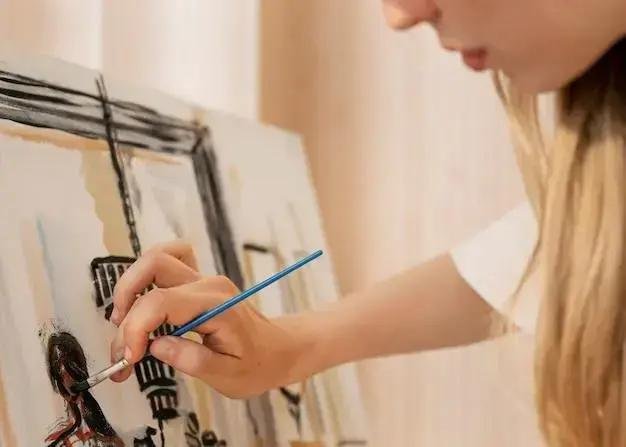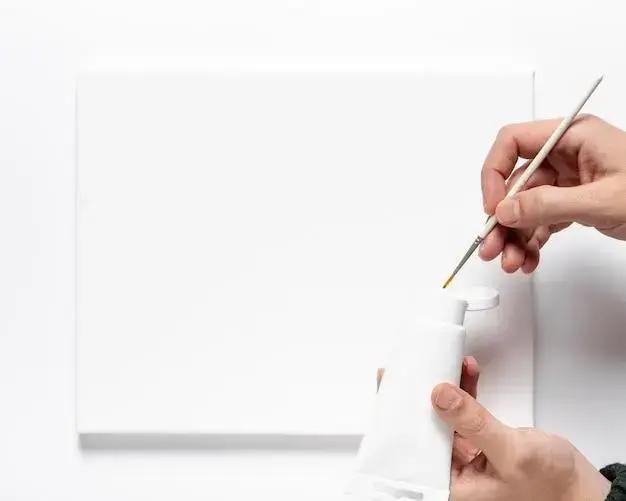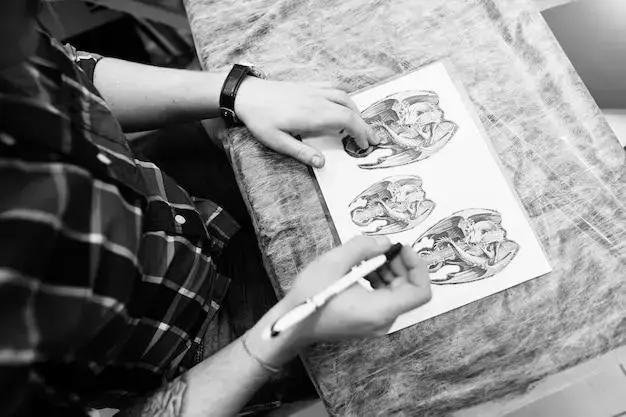Sketching basics are the foundation of any artist’s journey.
Whether you’re a beginner or looking to refine your skills, understanding these core principles can elevate your artwork to new heights.
From choosing the right tools to mastering shapes and forms, this guide will walk you through the essential elements of sketching that every artist should know.
Let’s dive into the world of sketching and unlock your creative potential!
Understanding Different Sketching Tools
When it comes to sketching, the tools you choose can significantly impact your creative process. Understanding different sketching tools is crucial for any artist, whether you’re just starting out or looking to expand your toolkit.
Pencils: The classic choice for sketching, pencils come in various hardness levels, from soft (B) to hard (H). Softer pencils are great for dark lines and shading, while harder pencils provide fine, light lines. A good set to start with might include a range from 2H to 6B, allowing you to experiment with different effects.
Charcoal: If you want to create bold, expressive sketches, charcoal is your go-to. It smudges easily, which can be both a blessing and a curse. While it allows for rich tones and textures, it also requires a bit of practice to control. Keep some blending stumps handy for softening edges and creating gradients.
Ink Pens: For a more permanent option, ink pens can add a crisp quality to your sketches. They come in various nib sizes and types, from fine liners to brush pens. Experimenting with different pens can help you find your preferred style, whether you like clean lines or a more fluid, calligraphic look.
Markers: Markers are fantastic for adding color and vibrancy to your sketches. They can be used for both outlines and filling in areas, but be aware that some markers can bleed through paper, so it’s wise to use sketch paper designed for markers.
Digital Tools: In today’s tech-savvy world, digital sketching tools like tablets and styluses have become increasingly popular. Programs like Procreate or Adobe Fresco allow you to sketch with an array of brushes and colors, offering endless possibilities. Plus, the ability to undo mistakes makes digital sketching a forgiving option for beginners.
Ultimately, the best tools are the ones that feel right for you. Don’t hesitate to try out different materials and find what resonates with your artistic style. Remember, sketching is about exploration and expression, so enjoy the journey!
Mastering Basic Shapes and Forms
Mastering basic shapes and forms is a fundamental skill for any aspiring artist. These shapes serve as the building blocks for more complex drawings, and understanding how to manipulate them can significantly enhance your sketching abilities.
Start with Simple Shapes: Begin by practicing basic shapes like circles, squares, triangles, and rectangles. These shapes are everywhere in our environment, and being able to draw them accurately is essential. Try sketching them in different sizes and orientations to get comfortable with their forms.
Combine Shapes: Once you’re comfortable with individual shapes, challenge yourself by combining them to create more complex forms. For instance, a human figure can be broken down into simple shapes: a circle for the head, rectangles for the torso and limbs, and ovals for the hands and feet. This method not only simplifies the drawing process but also helps you understand proportions and relationships between different body parts.
Practice 3D Forms: Next, take your basic shapes a step further by practicing three-dimensional forms. For example, turn a circle into a sphere, a square into a cube, and a triangle into a pyramid. This exercise will help you understand depth and perspective, which are crucial for creating realistic sketches.
Use Guidelines: When sketching, don’t be afraid to use light guidelines to help maintain proportions and angles. These can be erased later, but they provide a helpful framework as you build your shapes. For example, when drawing a face, lightly sketch an oval for the head and lines to indicate the placement of the eyes, nose, and mouth.
Experiment with Different Perspectives: To really master shapes and forms, practice drawing them from different angles. This will deepen your understanding of how they look in various perspectives and lighting conditions. Try sketching the same object from multiple viewpoints to see how it changes.
Remember, practice makes perfect! Spend time each day sketching basic shapes and forms, and soon you’ll find that they become second nature. As you build this foundation, you’ll be better equipped to tackle more intricate drawings with confidence.
The Importance of Light and Shadow
The importance of light and shadow in sketching cannot be overstated. They are essential elements that bring depth, dimension, and realism to your drawings. Understanding how to effectively use light and shadow can transform a flat sketch into a dynamic piece of art.
Understanding Light Sources: The first step in mastering light and shadow is to identify your light source. Whether it’s natural light from a window or an artificial light bulb, knowing where the light is coming from will help you determine how it interacts with objects. Light creates highlights on surfaces that face it and shadows on the opposite side, so take a moment to observe how light affects the objects around you.
Creating Highlights: Highlights are the areas where light hits an object directly. These spots should be drawn lightly, often using an eraser to lift graphite or charcoal from the paper. For example, when sketching a shiny apple, the highlight will be a small, bright area on its surface, making it appear more three-dimensional.
Defining Shadows: Shadows are equally important as they ground your objects and give them weight. There are two types of shadows to consider: the cast shadow, which is the shadow an object throws onto another surface, and the form shadow, which is the darker area on the object itself. When sketching, use darker tones to represent shadows, gradually blending them into lighter areas to create a smooth transition.
Value Scale Practice: To effectively depict light and shadow, practice creating a value scale. This involves drawing a gradient from pure white to pure black, with various shades of gray in between. Understanding this range will help you determine how dark or light to make your shadows and highlights in your sketches.
Using Reference Images: Studying reference images can also be incredibly helpful. Look for photographs with strong contrasts between light and shadow. Analyze how the light falls on different surfaces and try to replicate that in your sketches. This practice will enhance your ability to see light and shadow in your own work.
Incorporating light and shadow into your sketches adds life and dimension, making your artwork more engaging. So, grab your sketchbook and start observing how light interacts with the world around you. You’ll be amazed at the difference it makes!
Developing Your Own Sketching Style
Developing your own sketching style is an exciting journey that allows you to express your unique artistic voice. While it’s essential to learn the basics of sketching, finding your personal style will set your work apart and make it truly yours.
Explore Different Techniques: One of the best ways to discover your style is to experiment with various sketching techniques. Try using different tools like pencils, charcoal, ink, or even digital mediums. Each tool offers a distinct texture and feel, which can significantly influence your artistic approach. For example, using a brush pen may lead you to create more fluid and expressive lines, while a mechanical pencil might encourage precision and detail.
Study Other Artists: Look at the work of artists you admire, whether they are contemporary or historical figures. Analyze their techniques, use of color, and how they approach composition. This doesn’t mean you should copy them, but rather use their work as inspiration to develop your own interpretations. What elements resonate with you? Jot down notes or create a mood board to capture your findings.
Embrace Mistakes: Don’t be afraid to make mistakes along the way. Often, the most beautiful parts of art come from unexpected accidents. Allow yourself to experiment freely without the pressure of perfection. Sometimes, a happy accident can lead to a breakthrough in your style.
Reflect on Your Interests: Your personal interests and experiences can greatly influence your sketching style. Think about the subjects that excite you the most—nature, architecture, human figures, or abstract forms. Incorporating your passions into your work will make your sketches more authentic and engaging.
Practice Consistently: Developing a unique style takes time and practice. Make sketching a regular part of your routine, even if it’s just for a few minutes each day. The more you draw, the more your style will naturally evolve. Don’t rush the process; allow your artistic voice to emerge over time.
Seek Feedback: Sharing your work with others can provide valuable insights and encouragement. Join art communities, online forums, or local groups where you can showcase your sketches and receive constructive criticism. This feedback can help you refine your style and see your work from a new perspective.
Remember, developing your own sketching style is a personal journey. Embrace the process, be patient with yourself, and enjoy the exploration. Your unique artistic voice is waiting to be discovered!
Practicing Consistency and Patience
Practicing consistency and patience is crucial for any artist looking to improve their sketching skills. While it can be tempting to rush through your practice or seek instant results, true growth comes from a steady and thoughtful approach.
Set a Regular Schedule: One of the best ways to cultivate consistency is to set a regular sketching schedule. Whether it’s 15 minutes a day or a few hours a week, find a routine that works for you and stick to it. This commitment will help you develop your skills over time and make sketching a natural part of your life.
Focus on Small Goals: Instead of overwhelming yourself with ambitious projects, break your practice into smaller, achievable goals. For instance, you might focus on mastering a specific shape or technique each week. Celebrate these small victories, as they build your confidence and keep you motivated.
Embrace the Process: Remember that art is a journey, not a destination. Embrace the process of learning and growing, even when it feels frustrating. There will be days when your sketches don’t turn out as you envisioned, and that’s okay. Use those moments as opportunities to learn rather than as reasons to give up.
Keep a Sketchbook: Maintaining a sketchbook can be a fantastic way to track your progress over time. Use it to experiment, doodle, and document your artistic journey. Looking back at older sketches can be a great reminder of how far you’ve come and the skills you’ve developed.
Practice Mindfulness: Incorporating mindfulness into your sketching practice can enhance your focus and patience. Instead of rushing through your work, take a moment to breathe and connect with what you’re creating. This can lead to a more enjoyable experience and better results.
Seek Inspiration: Sometimes, a lack of motivation can hinder your practice. To combat this, seek inspiration from various sources—nature, books, art galleries, or even other artists. Engaging with different forms of art can reignite your passion and encourage you to keep sketching.
Ultimately, consistency and patience are your best friends on the path to becoming a skilled artist. By committing to regular practice and allowing yourself the grace to grow, you’ll find that your sketching abilities will flourish over time. So grab your sketchbook, stay patient, and enjoy the process!
Conclusion
In conclusion, mastering the fundamentals of sketching is an exciting journey that involves understanding tools, shapes, light, and shadow, while also developing your unique style.
Remember that consistency and patience are key to your growth as an artist. By regularly practicing and embracing the process, you’ll see your skills improve over time.
As you explore different techniques and seek inspiration, keep an open mind and don’t shy away from mistakes. They often lead to the most valuable learning experiences. Your sketchbook is your playground—use it to experiment, reflect, and document your artistic evolution.
Ultimately, the art of sketching is about expressing yourself and enjoying the creative process. So, keep sketching, stay curious, and watch as your artistic voice flourishes!
FAQ – Frequently Asked Questions About Sketching Basics
What are the best tools for beginners in sketching?
Beginners should start with a good range of pencils (2H to 6B), an eraser, and a sketchbook. Charcoal and ink pens can also be great for experimenting.
How can I improve my understanding of light and shadow?
Practice identifying light sources and observe how they affect objects. Create highlights and shadows in your sketches to add depth.
What should I do if I feel stuck in my sketching practice?
Try experimenting with new techniques or tools, seek inspiration from other artists, or set small goals to reignite your motivation.
How do I develop my own sketching style?
Explore different techniques, study artists you admire, and reflect on your interests. Allow your style to evolve naturally through consistent practice.
Why is consistency important in sketching?
Consistency helps solidify your skills over time. Regular practice allows you to refine your techniques and build confidence in your abilities.
How can I stay patient during my artistic journey?
Embrace the learning process, set realistic goals, and remember that growth takes time. Keeping a sketchbook can also help you track your progress.





